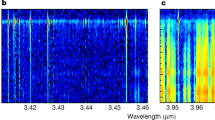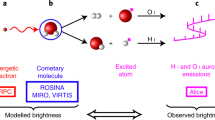Abstract
Enhanced mid-infrared emission from CH4 and other stratospheric hydrocarbons has been observed coincident with Jupiter’s ultraviolet auroral emission1,2,3. This suggests that auroral processes and the neutral stratosphere of Jupiter are coupled; however, the exact nature of this coupling is unknown. Here we present a time series of Subaru-COMICS images of Jupiter measured at a wavelength of 7.80 μm on 11–14 January, 4–5 February and 17–20 May 2017. These data show that both the morphology and magnitude of the auroral CH4 emission vary on daily timescales in relation to external solar-wind conditions. The southern auroral CH4 emission increased in brightness temperature by about 3.8 K between 15:50 ut, 11 January and 12:57 ut, 12 January, during a predicted solar-wind compression. During the same compression, the northern auroral emission exhibited a duskside brightening, which mimics the morphology observed in the ultraviolet auroral emission during periods of enhanced solar-wind pressure4,5. These results suggest that changes in external solar-wind conditions perturb the Jovian magnetosphere in such a way that energetic particles are accelerated into the planet’s atmosphere, deposit their energy as deep as the neutral stratosphere, and modify the thermal structure, the abundance of CH4 or the population of energy states of CH4. We also find that the northern and southern auroral CH4 emission evolved independently between the January, February and May images, as has been observed at X-ray wavelengths over shorter timescales6 and at mid-infrared wavelengths over longer timescales7.
This is a preview of subscription content, access via your institution
Access options
Access Nature and 54 other Nature Portfolio journals
Get Nature+, our best-value online-access subscription
$29.99 / 30 days
cancel any time
Subscribe to this journal
Receive 12 digital issues and online access to articles
$119.00 per year
only $9.92 per issue
Buy this article
- Purchase on Springer Link
- Instant access to full article PDF
Prices may be subject to local taxes which are calculated during checkout




Similar content being viewed by others
Data availability
The COMICS images presented here are publicly available on the SMOKA (Subaru Mitaka Okayama-Kiso Archive) system (https://smoka.nao.ac.jp/). Reduced and calibrated images may be requested from J.A.S. The Data Reduction Manager is a suite of IDL software designed for reduction and processing of planetary images and is available in compressed format from G.S.O. on request (glenn.s.orton@jpl.nasa.gov). The ionosphere-to-magnetosphere mapping calculation is also written in IDL and is available from M.F.V. on request (mvogt@bu.edu). Results of the solar-wind propagation model in a specific time period may be requested from C.T. (chihiro.tao@nict.go.jp). The NEMESIS forward model and retrieval tool is written in Fortran and is available as a GitHub repository; a user account for this repository may be requested from P.G.J.I. (patrick.irwin@physics.ox.ac.uk).
References
Caldwell, J., Gillett, F. C. & Tokunaga, A. T. Possible infrared aurorae on Jupiter. Icarus 44, 667–675 (1980).
Kim, S. J., Caldwell, J., Rivolo, A. R., Wagener, R. & Orton, G. S. Infrared polar brightening on Jupiter. III. Spectrometry from the Voyager 1 IRIS experiment. Icarus 64, 233–248 (1985).
Flasar, F. M. et al. An intense stratospheric jet on Jupiter. Nature 427, 132–135 (2004).
Grodent, D., Gérard, J.-C., Clarke, J. T., Gladstone, G. R. & Waite, J. H. A possible auroral signature of a magnetotail reconnection process on Jupiter. J. Geophys. Res. Space 109, A05201 (2004).
Nichols, J. D. et al. Response of Jupiter’s auroras to conditions in the interplanetary medium as measured by the Hubble Space Telescope and Juno. Geophys. Res. Lett. 44, 7643–7652 (2017).
Dunn, W. R. et al. The independent pulsations of Jupiter’s northern and southern X-ray auroras. Nat. Astron. 1, 758–764 (2017).
Sinclair, J. A. et al. Independent evolution of stratospheric temperatures in Jupiter’s northern and southern auroral regions from 2014 to 2016. Geophys. Res. Lett. 44, 5345–5354 (2017).
Bonfond, B. et al. The tails of the satellite auroral footprints at Jupiter. J. Geophys. Res. Space 122, 7985–7996 (2017).
Joy, S. P. et al. Probabilistic models of the Jovian magnetopause and bow shock locations. J. Geophys. Res. Space 107, 1309 (2002).
Grodent, D. et al. Jupiter’s aurora observed with HST during Juno orbits 3 to 7. J. Geophys. Res. Space 123, 3299–3319 (2018).
Drossart, P. et al. Thermal profiles in the auroral regions of Jupiter. J. Geophys. Res. 98, 18803 (1993).
Kita, H. et al. Characteristics of solar wind control on Jovian UV auroral activity deciphered by long-term Hisaki EXCEED observations: evidence of preconditioning of the magnetosphere? Geophys. Res. Lett. 43, 6790–6798 (2016).
Kostiuk, T. et al. Variability of mid-infrared Aurora on Jupiter: 1979 to 2016. In American Geophysical Union Fall Meeting 2016 P33C-2155 (AGU, 2016).
Zhang, X. et al. Radiative forcing of the stratosphere of Jupiter, part I: atmospheric cooling rates from Voyager to Cassini. Planet. Space Sci. 88, 3–25 (2013).
Seiff, A. et al. Thermal structure of Jupiter’s atmosphere near the edge of a 5-μm hot spot in the north equatorial belt. J. Geophys. Res. 103, 22857–22890 (1998).
Bougher, S. W., Waite, J. H., Majeed, T. & Gladstone, G. R. Jupiter thermospheric general circulation model (JTGCM): global structure and dynamics driven by auroral and Joule heating. J. Geophys. Res. Planets 110, E04008 (2005).
Gérard, J.-C. et al. Altitude of Saturn’s aurora and its implications for the characteristic energy of precipitated electrons. Geophys. Res. Lett. 36, L02202 (2009).
Yates, J., Achilleos, N. & Guio, P. Response of the jovian thermosphere to a transient ‘pulse’ in solar wind pressure. Planet. Space Sci. 91, 27–44 (2014).
Moses, J. I. et al. Photochemistry and diffusion in Jupiter’s stratosphere: constraints from ISO observations and comparisons with other giant planets. J. Geophys. Res. Planets 110, E08001 (2005).
Clark, G. et al. Precipitating electron energy flux and characteristic energies in Jupiter’s main auroral region as measured by juno/jedi. J. Geophys. Res. Space 123, 7554–7567 (2018).
Appleby, J. F. CH4 nonlocal thermodynamic equilibrium in the atmospheres of the giant planets. Icarus 85, 355–379 (1990).
Kim, S. J. Infrared processes in the Jovian auroral zone. Icarus 75, 399–408 (1988).
López-Puertas, M. & Taylor, F. Non-LTE Radiative Transfer in the Atmosphere (World Scientific, 2001).
Sinclair, J. A. et al. Jupiter’s auroral-related stratospheric heating and chemistry I: analysis of Voyager-IRIS and Cassini-CIRS spectra. Icarus 292, 182–207 (2017).
Sinclair, J. A. et al. Jupiter’s auroral-related stratospheric heating and chemistry II: analysis of IRTF-TEXES spectra measured in December 2014. Icarus 300, 305–326 (2018).
Halthore, R. N., Allen, J. E. Jr & Decola, P. L. A non-LTE model for the Jovian methane infrared emissions at high spectral resolution. Astrophys. J. Lett. 424, L61–L64 (1994).
Kostiuk, T., Romani, P., Espenak, F. & Livengood, T. A. Temperature and abundances in the Jovian auroral stratosphere. 2: ethylene as a probe of the microbar region. J. Geophys. Res. 98, 18823 (1993).
Livengood, T. A., Kostiuk, T. & Espenak, F. Temperature and abundances in the Jovian auroral stratosphere. 1: ethane as a probe of the millibar region. J. Geophys. Res. 98, 18813 (1993).
Nichols, J. D. & Milan, S. E. Stellar wind-magnetosphere interaction at exoplanets: computations of auroral radio powers. Mon. Not. R. Astron. Soc. 461, 2353–2366 (2016).
Cohen, O., Kashyap, V. L., Drake, J. J., Sokolov, I. V. & Gombosi, T. I. The dynamics of stellar coronae harboring hot Jupiters. II. A space weather event on a hot Jupiter. Astrophys. J. 738, 166 (2011).
Kataza, H. et al. COMICS: the cooled mid-infrared camera and spectrometer for the Subaru telescope. Proc. SPIE 4008, 1144–1152 (2000).
Okamoto, Y. K. et al. Improved performances and capabilities of the cooled mid-infrared camera and spectrometer (COMICS) for the Subaru telescope. Proc. SPIE 4841, 169–180 (2003).
Flasar, F. M. et al. Exploring the Saturn system in the thermal infrared: the composite infrared spectrometer. Space Sci. Rev. 115, 169–297 (2004).
Fletcher, L. N. et al. Retrievals of atmospheric variables on the gas giants from ground-based mid-infrared imaging. Icarus 200, 154–175 (2009).
Parrish, P. D. et al. Saturn’s atmospheric structure: the intercomparison of Cassini/CIRS-derived temperatures with ground-based determinations. Bull. Am. Astron. Soc. 37, 680 (2005).
Vogt, M. F. et al. Improved mapping of Jupiter’s auroral features to magnetospheric sources. J. Geophys. Res. Space 116, A03220 (2011).
Vogt, M. F. et al. Magnetosphere-ionosphere mapping at Jupiter: quantifying the effects of using different internal field models. J. Geophys. Res. Space 120, 2584–2599 (2015).
Hess, S. L. G., Bonfond, B., Zarka, P. & Grodent, D. Model of the Jovian magnetic field topology constrained by the Io auroral emissions. J. Geophys. Res. Space 116, A05217 (2011).
Tao, C., Kataoka, R., Fukunishi, H., Takahashi, Y. & Yokoyama, T. Magnetic field variations in the jovian magnetotail induced by solar wind dynamic pressure enhancements. J. Geophys. Res. Space 110, A11208 (2005).
Badman, S. V. et al. Weakening of Jupiter’s main auroral emission during January 2014. Geophys. Res. Lett. 43, 988–997 (2016).
Kinrade, J. et al. An isolated, bright cusp aurora at Saturn. J. Geophys. Res. Space 122, 6121–6138 (2017).
Lamy, L. et al. The aurorae of Uranus past equinox. J. Geophys. Res. Space 122, 3997–4008 (2017).
Thatcher, L. J. & Müller, H.-R. Statistical investigation of hourly OMNI solar wind data. J. Geophys. Res. Space 116, A12107 (2011).
Zieger, B. & Hansen, K. C. Statistical validation of a solar wind propagation model from 1 to 10 AU. J. Geophys. Res. Space 113, A08107 (2008).
Irwin, P. G. J. et al. The NEMESIS planetary atmosphere radiative transfer and retrieval tool. J. Quant. Spectrosc. Rad. Transfer 109, 1136–1150 (2008).
Fletcher, L. N. et al. The origin and evolution of Saturn’s 2011–2012 stratospheric vortex. Icarus 221, 560–586 (2012).
Acknowledgements
All data presented were obtained at the Subaru Telescope, which is operated by the National Astronomical Observatory of Japan. COMICS observations obtained on 11, 12 January and 19, 20 May were proposed by and awarded to Y.K. using Subaru classical time. COMICS observations on 13, 14 January, 4, 5 February and 17, 18 May were proposed by and awarded to G.S.O. through the Keck-Subaru time exchange programme. We acknowledge the W. M. Keck Observatory, which is operated as a scientific partnership between California Institute of Technology, the University of California and NASA and supported financially by the W. M. Keck Foundation. We recognize and acknowledge the very important cultural role and reverence that the summit of Maunakea has always had within the indigenous Hawaiian community. We are most fortunate to have the opportunity to conduct observations from this mountain. The research was carried out at the Jet Propulsion Laboratory, California Institute of Technology, under a contract with NASA. We thank the NASA Postdoctoral and Caltech programmes for funding and supporting J.A.S. during this research. G.S.O. was supported by grants from NASA to the Jet Propulsion Laboratory/California Institute of Technology.
Author information
Authors and Affiliations
Contributions
J.A.S. led the analysis of the observations and the preparation of this Letter. G.S.O. and Y.K. were principal investigators of the awarded telescope time. J.A.S., G.S.O., Y.K., T.M.S. and T.F. participated in the measurements at the Subaru Telescope. J.F. performed the reduction and calibration of the images. C.T. and M.F.V. provided model output for the interpretation of the results. P.G.J.I. is the lead developer of the NEMESIS code. All remaining authors contributed to the interpretation of the results and the preparation of the Letter.
Corresponding author
Ethics declarations
Competing interests
The authors declare no competing interests.
Additional information
Publisher’s note: Springer Nature remains neutral with regard to jurisdictional claims in published maps and institutional affiliations.
Supplementary information
Supplementary Information
Supplementary Figures 1–5, Supplementary Table, Supplementary References
Rights and permissions
About this article
Cite this article
Sinclair, J.A., Orton, G.S., Fernandes, J. et al. A brightening of Jupiter’s auroral 7.8-μm CH4 emission during a solar-wind compression. Nat Astron 3, 607–613 (2019). https://doi.org/10.1038/s41550-019-0743-x
Received:
Accepted:
Published:
Issue Date:
DOI: https://doi.org/10.1038/s41550-019-0743-x
This article is cited by
-
Moons and Jupiter Imaging Spectrometer (MAJIS) on Jupiter Icy Moons Explorer (JUICE)
Space Science Reviews (2024)
-
Feedback between Jupiter’s atmosphere and magnetic environment
Nature Reviews Physics (2019)



